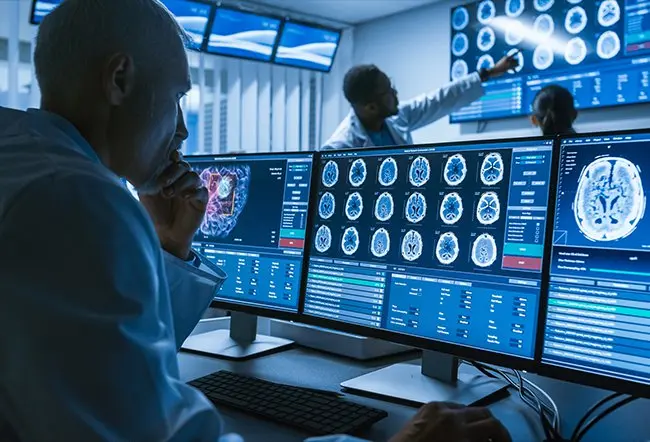
A brain bleed (brain hemorrhage) occurs when blood vessels in the brain are damaged, such as by a head injury, problems with blood clotting and/or damage to the blood vessels in the brain, or a ruptured brain aneurysm. Bleeding in the brain increases pressure on brain tissue and can lead to serious complications.
There are several types of brain bleeds, all of which can cause significant complications and can be life-threatening. While most people who experience a brain bleed will live, they usually experience problems with memory, speech, or movement, depending on the location of the brain bleed.
- A brain bleed can be life-threatening when blood enters the fluid-filled space around the brain (the subarachnoid space), in what is called a subarachnoid hemorrhage. When blood flows into the subarachnoid space it can spread quickly and put pressure on the entire brain so even parts of the brain that aren't close to the bleeding blood vessel can be damaged.
- Left untreated, a subarachnoid hemorrhage can lead to unconsciousness and life-threatening complications such as an irregular heartbeat and respiratory arrest. It can cause brain damage that may result in long-term or permanent problems such as speech difficulty or paralysis.
- When a brain bleed occurs within the brain tissue, it’s called an intracerebral hemorrhage (a brain hemorrhage) and the blood presses against the tissue from the inside and against other blood vessels in that area causing the surrounding brain tissue to die. Depending on the function of that part of the brain, problems with vision, speech, movement, or sensation can occur. It can also lead to life-threatening complications.
- Blood can also leak into the small gaps between the meninges (membranes covering the brain) in a subdural hematoma or between the meninges and the skull in an epidural hematoma. These conditions can also cause brain damage.
What Are Symptoms of a Brain Bleed?
Symptoms of a brain bleed (brain hemorrhage) vary depending on the location and severity of the bleeding and the amount of brain tissue is affected. Symptoms can develop suddenly or gradually over time. It’s important to seek medical attention immediately if a brain bleed is suspected.
Symptoms of a brain bleed may include:
- Sudden, severe headache
- Numbness or tingling of an extremity, often on only one side
- Weakness
- Nausea or vomiting
- Drowsiness
- Reduced alertness
- Loss of consciousness
- Confusion, including difficulty speaking or understanding speech
- Vision changes
- Problems balancing and walking
- Changes in taste
- Seizures, with no previous history of seizures
What Causes a Brain Bleed?
Causes of a brain bleed (brain hemorrhage) include:
- High blood pressure
- Untreated high blood pressure (hypertension) is the most common cause of brain bleeds
- Brain arteries weaken due to excess force of blood against the walls of the arteries, resulting in a brain bleed
- Head trauma
- A common cause of disability
- Even a simple bump on the head could result in brain damage if it causes a brain bleed
- Ruptured brain aneurysm
- Caused by a weak spot in a blood vessel that balloons out and bursts
- Bleeding disorders
- Drug abuse
- Cocaine and other illicit drugs can weaken blood vessels
- Some prescription drugs can also increase the risk of a brain hemorrhage
- Blood vessel abnormalities, or arteriovenous malformations (AV)
- A rare cause of brain bleeds
- A group of blood vessels in the brain does not form correctly before birth and can cause leaking arteries or veins
How Is a Brain Bleed Diagnosed?
A rapid diagnosis of a brain bleed (brain hemorrhage) is needed to get prompt and proper treatment. The cause of a brain bleed is not always apparent when a patient arrives at an emergency room unless there is obvious head trauma. Patients who are conscious may be asked to describe their symptoms.
Tests used to diagnose a brain bleed may include:
- Imaging tests
- Computed tomography angiography (CTA)
- Computed tomography (CT) scan
- Magnetic resonance imaging (MRI) scan
- Vascular ultrasound
- Electroencephalogram (EEG)
- Intracranial pressure monitoring
What Is the Treatment for a Brain Bleed?
Brain bleeds (brain hemorrhages) may be treated surgically or nonsurgically, depending on the cause, severity, and location of the brain bleed, and the patient’s overall health.
Early treatment is aimed at stabilizing the patient in the intensive care unit (ICU) and includes:
- Supportive care
- Strict regulation of blood pressure
- Strict regulation of breathing status
Surgery to treat a brain bleed may include:
- Burr hole
- A procedure to drill a hole into the skull that allows excess blood to drain
- Craniotomy
- An incision through the scalp is made and a special saw is used to remove a piece of the skull to allow the brain to expand and relieve the pressure created by the bleeding
- External ventricular drain
- A catheter is placed into the cavities (ventricles) of the brain to relieve pressure and decompress the cerebrospinal fluid
- Clipping or repairing an aneurysm
- A clip is used to secure the bleed
- Removal of arteriovenous malformation (AVM)
- The abnormal mass of blood vessels is removed or plugged off
Health Solutions From Our Sponsors
From 
Healthy Resources
Featured Centers
Health Solutions From Our Sponsors
https://www.ncbi.nlm.nih.gov/books/NBK541154/
https://www.rwjbh.org/treatment-care/neuroscience/neurosurgery/conditions-treated/hemorrhage/
